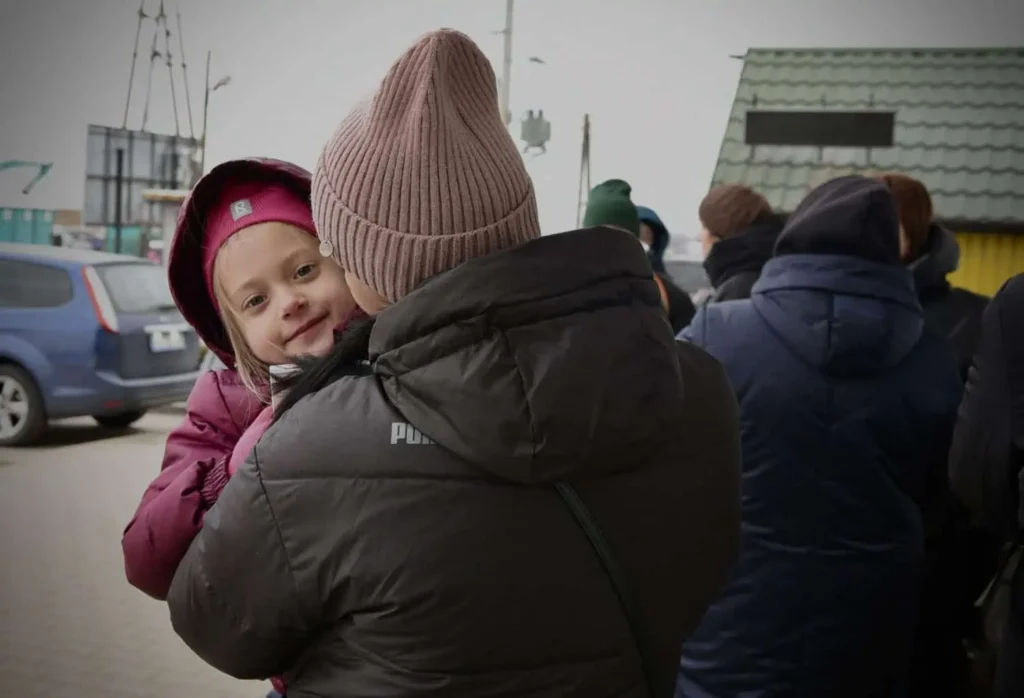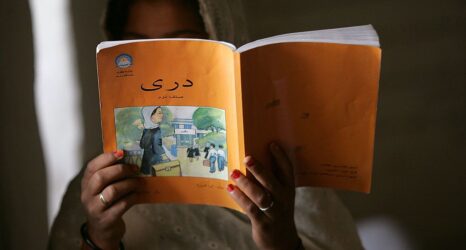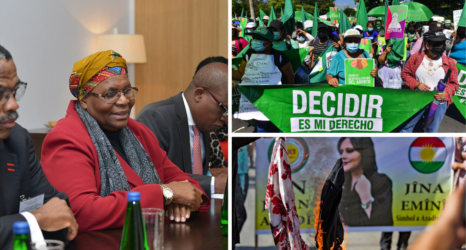It’s up to all of us to think about how bringing feminist lenses to foreign policy could change the prosecution and effects of conflict.

This story was originally published on PassBlue.
Mothers appeal to mothers. Who doesn’t understand the power of women speaking to women about fear for their children? We listen as young women—parliamentarians, government ministers—who are staying to defend their country and denounce the insufficiencies of allies’ support. Who doesn’t perceive that their authority is enhanced because their decision to stay and fight is voluntary: “She didn’t have to do it”; she, too, could be in the crowd of women and children climbing into trains and buses to Poland, Hungary, other points west?
Who doesn’t know that the fighting is largely the work of men?
In Ukraine, once again, the rules of conscription and refuge are following a familiar pattern: Men to the front, women and children to shelter, inside and outside the country. And when we see the women politicians or grassroots advocates or journalists deploying all the means at their disposal to fight militarily and on the terrain of public opinion, our momentary surprise (generally not commented upon) highlights how conventional our expectations still are when it comes to war.
Anyone who has been in, or even simply watched, a war knows that gender articulates its preparation, prosecution, immediate effects and long-term consequences and knows also that wars shape gender. Conflict hardens distinctions but also scrambles them, which is why those parliamentarians and grassroots advocates and journalists are not really a surprise but nor is, unfortunately, the discrimination faced by people of African or Asian descent trying to leave Ukraine and nor will be the stories of sexual violence when they start to emerge.
The gendered nature of war, then, is common knowledge—it is to the large number of feminists who have been working on it for years; it must be to the growing number of countries (Sweden, Canada, France, Luxembourg, Spain, Mexico, Libya, Germany and now Chile)—call them the FFP9—that have declared that they pursue feminist foreign policies. But even those countries that proudly disdain feminism as a guide to international relations have at least paid lip service to the U.N. Security Council’s women, peace and security agenda; NATO’s efforts to integrate gender perspectives into its core tasks of collective defense, crisis management and cooperative security; and the European Union’s longstanding policies promoting gender equality as a basic right. And yet, to date, there has been little evidence that either the FFP9 or other countries have assigned a central role to gender in developing their policies to Ukraine.
Of course, there are many varieties of feminism and several understandings of the terrain that feminist foreign policies must cover. According to Margot Wallstrom, Sweden’s former foreign minister who launched the idea, a feminist policy rests on four “Rs”: rights, representation, resources and realism. There are also more inclusive views that, for example, take intersectional disadvantages into account, but the Swedish formulation has the benefit of clarity. It asks whether girls and women have access to the same rights as boys and men; if they are represented at all levels of government; if adequate resources have been allocated to rectifying women and girls’ disadvantages; and, finally, if a realistic assessment of the likelihood (and trajectories) of success has been advanced.
This means, in the first place, insisting on gender equality at any future or current negotiating tables and centering the voices of those who have been most directly affected by conflict. But the proponents of feminist foreign policies also need to ensure that an understanding of the gendered implications of this conflict informs the policies that are pursued today. Otherwise, feminist aspirations to shape foreign policy will be consigned to the dustbin—and that will provide an unintended bonus to Putin, who has aggressively pursued a “traditional values” agenda that has trampled on gender-related rights for decades. If the FFP9 can promote an agenda that strives to ensure gender equity—or, at the very least, not to exacerbate inequity—even in the midst of conflict, they will have demonstrated the added, and potentially transformative, value of feminist foreign policies.
It is not too early to start developing such an agenda—and for those of us who do not have feminist state departments to prepare as well. We should do so by gathering information regarding the impacts of the conflict and the policies our own governments are pursuing.
What does this mean? Among other questions, we should ask about the gendered and intersectional impacts of Ukraine’s wartime economy, of the collapse of the ruble and of remittances from Russia and elsewhere; about the gendered impacts of sanctions, both on the sanctioned and on the sanctioning (who bears the price of higher fuel and food prices?); about the effects of the highly gendered emigration patterns and the dangers with which they may be associated, from gender-based violence to illicit markets in brides and babies as well as the risks associated with the hyper-masculinization of the society for those who stay.
Just as we should recognize the possible negative effects of a masculinized, militarized and armed society, where every form of gender-based discrimination may soar, we need to know that women may acquire new skills and new authority, and that we should try to help safeguard these advances. This war may defend democracy, but it may also signal an expansion of authoritarian power hostile to feminism in all its forms.
It’s not just for embattled Ukrainians to start planning but for all of us to think about how bringing feminist lenses to foreign policy could change the prosecution and effects of the conflict.












